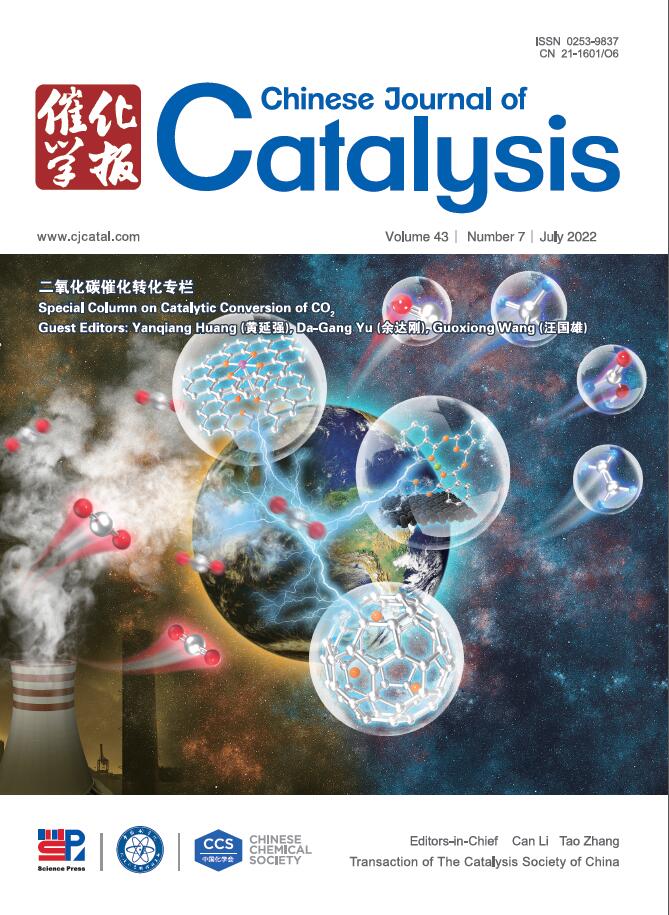Chelating-agent-free incorporation of isolated Ni single-atoms within BEA zeolite for enhanced biomass hydrogenation
IF 15.7
1区 化学
Q1 CHEMISTRY, APPLIED
引用次数: 0
Abstract
Precisely tailoring metal single-atoms within zeolite scattfolds and understanding the origin of the unique behavior of such atomically dispersed catalysts are pivotal and challenge in chemistry and catalysis. Herein, we have successfully fabricated Ni single-atoms within BEA zeolite (Ni1@Beta) through a facile in situ two-step hydrothermal strategy, notably without using any chelating agent for stabilizing Ni species. With the aid of advanced characterization techniques, such as aberration-corrected high-angle annular dark-field scanning transmission electron microscopy, X-ray absorption spectroscopy, etc., and combined with density functional theory calculations, the nature and micro-environment of isolated Ni species, which are incorporated within 6-membered rings and stabilized by four skeletal oxygens of Beta zeolite, have been identified. The as-obtained Ni1@Beta exhibits a superior performance in terms of activity (with a turnover frequency value up to 114.1 h–1) and stability (for 5 consecutive runs) in the selective hydrogenation of furfural, surpassing those of Ni nanoparticle analogues and previously reported Ni-based heterogeneous catalysts. This study provides an efficient strategy for the fabrication of non-noble metal single-atoms within zeolites, which could be of great help for the design of metal-zeolite combinations in the chemoselective reactions involved in biomass conversion and beyond.
在BEA沸石中无螯合剂掺入分离的Ni单原子以增强生物质加氢
在沸石散射层中精确剪裁金属单原子,了解这种原子分散催化剂独特行为的起源是化学和催化领域的关键和挑战。在此,我们通过简单的原位两步水热策略成功地在BEA沸石(Ni1@Beta)中制备了Ni单原子,特别是没有使用任何螯合剂来稳定Ni物种。借助像差校正高角环形暗场扫描透射电镜、x射线吸收光谱等先进表征技术,结合密度功能理论计算,鉴定了被β沸石的4个骨架氧稳定在6元环内的分离镍的性质和微环境。所获得的Ni1@Beta在糠醛选择性加氢的活性(周转频率值高达114.1 h-1)和稳定性(连续5次运行)方面表现出优异的性能,超过了Ni纳米颗粒类似物和先前报道的Ni基非均相催化剂。该研究为非贵金属单原子在沸石内的制备提供了一种有效的策略,这对金属-沸石组合在生物质转化等化学选择反应中的设计有很大的帮助。
本文章由计算机程序翻译,如有差异,请以英文原文为准。
求助全文
约1分钟内获得全文
求助全文
来源期刊

Chinese Journal of Catalysis
工程技术-工程:化工
CiteScore
25.80
自引率
10.30%
发文量
235
审稿时长
1.2 months
期刊介绍:
The journal covers a broad scope, encompassing new trends in catalysis for applications in energy production, environmental protection, and the preparation of materials, petroleum chemicals, and fine chemicals. It explores the scientific foundation for preparing and activating catalysts of commercial interest, emphasizing representative models.The focus includes spectroscopic methods for structural characterization, especially in situ techniques, as well as new theoretical methods with practical impact in catalysis and catalytic reactions.The journal delves into the relationship between homogeneous and heterogeneous catalysis and includes theoretical studies on the structure and reactivity of catalysts.Additionally, contributions on photocatalysis, biocatalysis, surface science, and catalysis-related chemical kinetics are welcomed.
 求助内容:
求助内容: 应助结果提醒方式:
应助结果提醒方式:


